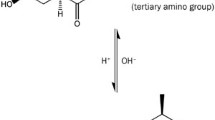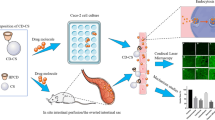Summary
The purpose of this study was to investigate the transport characteristics and mechanisms for discovering the possible causes of the low bioavailability of astragaloside IV and to develop an absorption enhancement strategy. Caco-2 cells used as the in vitro model. Results showed a low permeability coefficient (3.7×l0−8cm/s for transport from the AP to BL direction), which remained unchanged throughout the concentration range studied, indicating that the transport of astragaloside IV was predominantly via a passive route. The AP to BL transport of astragaloside IV was found to be highly sensitive to the extracellular Ca2+ concentration, which suggested that its transport may be via a paracellular route. Both chitosan and sodium deoxycholate can increase the permeation efficiency of astragaloside IV. This study indicated that astragaloside IV having a low fraction dose absorbed in humans mainly due to its poor intestinal permeability, high molecular weight, low lipophilicity as well as its paracelluar transport may directly result in the low permeability through its passive transport. Meanwhile, chitosan and sodium deoxycholate can be used as absorption enhancers based on its transport mechanism.
Similar content being viewed by others
References
Hikino, H., Funayama, S., Endo, K. (1976): Hypotensive principle ofAstragalus andHedysarum roots. Planta Med. 30, 297.
Zhang, W.J., Hufnagl, P., Binder, B.R., et al (2003): Antiinflammatory activity of astragaloside IV is mediated by inhibition of NF-kappaB activation and adhesion molecule expression. Thromb Haemost 90, 904–914.
Bedir, E., Pugh, N., Calis, I., et al (2000): Immunostimulatory effects of cycloartane-type triterpene glycosides fromAstragalus species. Biol. Pharm. Bull 23, 834.
Li, Z.P., Cao, Q. (2002): Effects of astragaloside IV on myocardial calcium transport and cardiac function in ischemic rats. Acta Pharmacol. Sin. 23, 898–904.
Yang, Q., Lu, J.T., Zhou, A.W., et al (2001): Antinociceptive effect of astragalosides and its mechanism of action. Acta Pharmacol. Sin. 22, 809–12.
Zhang, Y.D., Shen, J.P., Zhu, S.H., et al (1992): Effects of astragalus (ASI, SK) on experimental liver injury. Yao Xue Xue Bao, 27, 401–406.
Ma, Z., Yang, Z. (1999): Scavenging effects ofAstragalus and Gynostemma pentaphyllum with its products on O2− · and · OH, Zhong Yao Cai 22, 303–306.
Luo, Y., Qin, Z., Hong, Z. (2004): Astragaloside IV protects against ischemic brain injury in a murine model of transient focal ischemia, Neuro. Let. 363, 218–223.
Gu, Y., Wang, G., Pan, G. Y. (2004): Transport and bioavailability studies of astragaloside IV, an active ingredient inRadix astragali. Basic Clin. Pharmacol. Toxicol. 95, 295–298.
Gan, L.S.L., Thakker, D.R. (1997): Applications of the Caco-2 model in the design and development of orally active drugs elucidation of biochemical and physical barriers posed by the intestinal epithelium. Adv. Drug Deliv. Rev. 23, 77–98.
Artursson, P., Karlsson, J. (1991): Correlation between oral drug absorption in humans and apparent drug permeability coefficients in human intestinal epithelial (Caco-2) cells. Biochem. Biophys. Res. Commun. 175, 880–885.
Artursson, P., Magnusson, C. (1990): Epithelial transport of drugs in cell culture. II. Effect of extracellular calcium concentration on the paracellular transport of drugs of different lipophilicities across monolayers of the intestinal epithelial (Caco-2) cells. J. Pharm. Sci 79, 595–600.
De Boer, A., Noach, A., Roosemalen, M., et al (1991): Effect of apical and/or basolateral application of EDTA on the permeability of hydrophilic compounds in a human intestinal epithelial cell line (Caco-2). Pharm. Res. 8, S215.
Artursson, P. (1991): Cell cultures as models for drug absoption across the intestinal mucosa. Crit. Rev. Ther. Drug Carrier Syst. 8, 305–330.
Artursson, P., Lindmark, T., Davis, S.S. et al (1994): Effect of chitosa on the permeability of monolayers of intestinal epithelial cells (Caco-2). Pharm. Res. 11, 1358–1361.
Ilium, L., Farraj, N.F., Davis, S.S. (1994): Chitosan as a novel nasal delivery system for peptide drugs. Pharm. Res. 11, 1186–1189.
Schipper, N.G., Varum, K.M., Artursson, P. (1996): Chitosan as absorption enhancers for poorly absorbable drugs. 1. Influence of molecular weight and degree of acetylation on drug transport across human intestinal epithelial (Caco-2) cells. Pharm. Res. 13, 1686–1692.
Shin, S.C., Bum, J.P., Choi, J.S. (2000): Enhanced bioavailability by buccal administration of triamcinolone acetonide from the bioadhesive gels in rabbits. Int. J. Pharm. 209, 37–43.
Uchiyama.T., Sugiyama, T., Quan, Y.S., et al (1999): Enhanced permeability of insulin across the rat intestinal membrane by various absorption enhancers: their intestinal mucosal toxicity and absorption-enhancing mechanism of n-lauryl-beta-D-maltopyranoside. Pharm. Pharmacol. 51, 1241–1250.
Sakai, M., Imai, T., Ohtake, H., et al (1999): Simultaneous use of sodium deoxycholate and dipotassium glycyrrhizinate enhances the cellular transport of poorly absorbed compounds across Caco-2 cell monolayers. J. Pharm. Pharmacol. 51, 27–33.
Author information
Authors and Affiliations
Rights and permissions
About this article
Cite this article
Huang, C.R., Wang, G.J., Wu, X.L. et al. Absorption enhancement study of astragaloside IV based on its transport mechanism in Caco-2 cells. European Journal of Drug Metabolism and Pharmacokinetics 31, 5–10 (2006). https://doi.org/10.1007/BF03190635
Received:
Issue Date:
DOI: https://doi.org/10.1007/BF03190635




